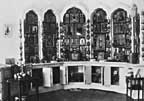Travel Guides - Seven League Boots
by Richard Halliburton
by Richard Halliburton
Indianapolis
The Bobs-Merrill Company
1935
Pages 153-55
 My encounters in Sverdlovsk, and my visit to the death-house had given me a keen desire to see the Czar's palace at Tsarskoe Selo, where, so I learned, every room remains exactly as the Romanoffs left it on the day they departed for their Siberian exile.
My encounters in Sverdlovsk, and my visit to the death-house had given me a keen desire to see the Czar's palace at Tsarskoe Selo, where, so I learned, every room remains exactly as the Romanoffs left it on the day they departed for their Siberian exile.
On reaching Leningrad I took a motorcar at once to this country place, and spent an afternoon wandering through the great empty house that once had been home to a man and his wife and their five children.
Empty- but only of people. Every book and picture and bed and chair is there, untouched since the family walked away one morning and never came back. The Czarina's gowns of silk and satin still hang in the wardrobe. From every appearance of the Czar's desk, he might have left it five minutes ago. Arranged around the top are eighteen photographs of his family: Olga and her first court dress; the Czarina and little Tatiana; Alexis as a baby, playing with his dog; the Czar and Czarina on their wedding day....
In one of the formal reception rooms is preserved a wooden slide which Alexis and Anastasia kept polished on rainy afternoons. And there is Alexis' miniature automobile, the latest 1917 model�rubber tires, cutglass lamps�in which he could pedal himself about the palace corridors, honking his horn furiously as he pursued his shouting sisters. If one has ever had a child who owned and loved a similar tin automobile, or if one has ever been a child and pedaled one's own play wagon, the sight of this toy, so lonesome and neglected looking, will make the memory of its imperial little chauffeur's cold-blooded assassination, in the guard-room at Ekaterinburg, doubly poignant and doubly cruel.
The Czar's and Czarina's bedroom gives us some insight into their minds. The Czar's passion for family photographs runs riot here. One hundred and fifty clutter every space. The tables, the walls, the cabinets, are hidden under photographs. The Czarina has expressed herself too. In the alcove, above the two brass beds, are six hundred ikons. At the side of the room is a cheap wash-stand supporting a china wash-bowl and pitcher.

Above: Bedroom of the Czar and Czarina in their palace at Tsarskoe Selo, near Leningrad, containing the Czarina's collection of six hundred ikons and the Czar's collection of one hundred and fifty family photographs.

Above right: A drawing room at Tsarskoe Selo. On the wooden slide the Romanoff children played on rainy days. Alexis' toy automobile, latest 1917 model, stands beside it. Before the windows are seen the Czarina's court dresses.
But the Czar and his wife were happy here. This was their sanctuary, to be adorned as capriciously as they liked - a refuge where they could be at peace, surrounded by the love of their children and their saints.The billiard room reveals the key to the final chapter of the family's history. Here, during the war, the Czar and his generals spread the war maps on the billiard table, and worked out each new campaign, each new attack, retreat and strategic move. Just above is a halfhidden balcony. In this balcony the Czarina, remaining unobserved, and not trusting her husband's ability to direct the course of the war, listened to the discussions below. And then, after counseling with Rasputin, she secretly aided - or blocked - the military plans, as she, a patriotic and well-meaning but irresponsible woman, thought best.
It is interesting to speculate what might have happened had a less neurotic, more comprehending Empress been hiding in that balcony. It is possible that the Czar, with his susceptibility to guidance, good as well as bad, might still be on the throne today. Undoubtedly there would never have been the national disgrace of Ekaterinburg - an atrocity which future generations of Russians, when the political prejudices of the present day have passed and a dispassionate viewpoint has been attained, will acknowledge to have been one of the blackest and most shameful pages in history.
Please send your comments on this page and the Time Machine to boba@pallasweb.com





 Imperial Bedroom
Imperial Bedroom Portrait Hall
Portrait Hall Mauve Room
Mauve Room Maple Room
Maple Room Aleksey's Bedroom
Aleksey's Bedroom Nicholas's Study
Nicholas's Study Aleksey's Playroom
Aleksey's Playroom Formal Reception
Formal Reception Balcony View
Balcony View Aleksey- Balcony
Aleksey- Balcony Children-Mauve
Children-Mauve Nicholas's Bathroom
Nicholas's Bathroom Alexandra- Mauve
Alexandra- Mauve Nicholas's Reception
Nicholas's Reception Tsarskoe Selo Map
Tsarskoe Selo Map